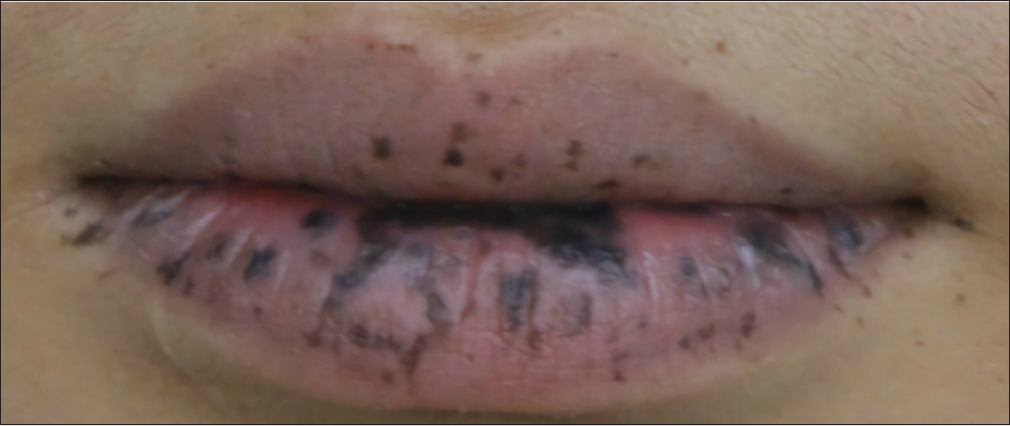Translate this page into:
Successful treatment of oral pigmented spots in Chinese subjects with Peutz-Jeghers syndrome using a 755-nm picosecond laser
Corresponding author: Prof. Tong Lin, 12 Jiangwangmiao Street, Nanjing 210042, Jiangsu Province, China. ddlin@hotmail.com
-
Received: ,
Accepted: ,
How to cite this article: Zeng R, Wu Q, Gu L, Lin T. Successful treatment of oral pigmented spots in Chinese subjects with Peutz-Jeghers syndrome using a 755-nm picosecond laser. Indian J Dermatol Venereol Leprol 2021;87:288-9.
Sir,
Picosecond 755-nm alexandrite laser is a novel type of short pulse width laser used for treating pigmented skin diseases. It has achieved good results in the treatment of pigment-enhancing skin diseases such as freckles and nevus of Ota.1,2 However, its usefulness in Peutz-Jeghers Syndrome has not been reported yet. We report two patients who responded successfully to picosecond 755-nm alexandrite laser.
Two patients, one a 17-year-old female and another a 15-year-old male, presented with multiple well- defined irregular brown to black macules on the upper and lower lips. The macules were present since early childhood and were increasing in number with age. No similar macules were observed elsewhere in the body. Both patients gave history of abdominal pain and the second patient had frequent diarrhea also. Hence, they had undergone colonoscopy which revealed intestinal polyps and those were surgically resected. A diagnosis of PJS was made in both the cases. Neither of them had any family history of genetic disorders.
Picosecond 755-nm alexandrite laser (Picosure®; Cynosure; Westford, MA) was used to treat the hyperpigmented macules on the lips of both the patients. No topical anaesthesia was used. For the first patient, an energy setting of 2.83 to 4.07 J/cm2 and spot size from 2.5 to 3.0mm was used and she received a total of two sessions delivered at three-monthly interval. The second patient received only one treatment session with an energy setting of 2.08 to 2.83 J/cm2 and spot size from 3.0 to 3.5 mm. Independent physician assessment revealed 50%–75% improvement after three months in both the patients and an almost 100% improvement was noted in the first patient after the second treatment session [Figures 1 and 2]. The first patient did not have any remarkable side effects whereas the second patient developed erythema and edema but had no long-term adverse effects such as pigmentation or scar formation. Even after one year no evidence of recurrence was seen in either of the patients. PJS is an epidermal pigmentation disorder characterized by mucocutaneous lentigines. Recently, short pulse width lasers such as the 755-nm and 532-nm Q-switched lasers have been used to remove such lesions on the oral labial mucosa without side effects such as scars.3-5 However, such lasers usually require multiple rounds of treatment to achieve very good results. In our previous study on Q-switched Nd: YAG laser treatment for PJS, we found that on an average, 3.6 treatment sessions are needed to achieve greater than 75% improvement with the following parameters: 5–20 ns pulse duration and 1.8–2.2 J/ cm2 fluence.5 In Li’s retrospective analysis of 43 patients who underwent three sittings of Q-switched 755-nm alexandrite laser treatment with 5–7 J/cm2 of energy, 33.3%, 50% and 100% of the patients showed more than 75% improvement after one, two and three treatment sessions, respectively.3 Both our patients achieved greater than 75% improvement after only one treatment using a picosecond laser with 2.08 to 4.07 J/cm2 of energy. Our picosecond laser required significantly fewer treatment sessions than the two types of Q-switched lasers previously described. The reason for this phenomenon may be that the pulse width of the picosecond laser (500-900 picoseconds) is much shorter than that of the Q-switched laser (50 nanoseconds).Hence the energy can be highly concentrated in the target pigment and can destroy it at once. Our previous study comparing the picosecond 755-nm alexandrite laser and Q-switched 755-nm alexandrite laser for the treatment of nevus of Ota supports this view.2 In that study, we found that picosecond 755-nm alexandrite laser can achieve a significantly better clearance with fewer sessions and less pain.

- Clinical images. Patient 1: Before treatment

- Clinical images. Patient 1: After first treatment session

- Clinical images. Patient 1: After second treatment session

- Clinical images. Patient 2: Before treatment

- Clinical images. Patient 2: After one treatment session
In conclusion, the successful treatment of these two patients indicate that the picosecond 755-nm laser is a good treatment option for Peutz-Jeghers syndrome. We were unable to find any previous reports in which picosecond 755-nm laser was used to treat this condition.
Declaration of patient consent
The authors certify that they have obtained all appropriate patient consent.
Financial support and sponsorship
CAMS Innovation Fund for Medical Sciences (CIFMS-2017-I2M-1-017 CIFMS 2018-I2M -AI-018).
Conflicts of interest
There are no conflicts of interest.
References
- Comparison of the efficacy and safety of a picosecond alexandrite laser and a Q switched alexandrite laser for the treatment of freckles in Chinese patients. J Am Acad Dermatol. 2018;79:1155-6.
- [CrossRef] [PubMed] [Google Scholar]
- Comparison of a picosecond alexandrite laser versus a Q switched alexandrite laser for the treatment of nevus of Ota: A randomized, split lesion, controlled trial. J Am Acad Dermatol. 2020;83:397-403.
- [CrossRef] [PubMed] [Google Scholar]
- Q switched alexandrite laser treatment of facial and labial lentigines associated with Peutz Jeghers syndrome. Photodermatol Photoimmunol Photomed. 2012;28:196-9.
- [CrossRef] [PubMed] [Google Scholar]
- Q switched alexandrite laser treatment of oral labial lentigines in Chinese subjects with Peutz Jeghers syndrome. Dermatol Surg. 2009;35:1084-8.
- [CrossRef] [PubMed] [Google Scholar]
- Q switched Nd: YAG laser treatment for labial lentigines associated with Peutz Jeghers syndrome. J Dtsch Dermatol Ges. 2015;13:551-5.
- [CrossRef] [PubMed] [Google Scholar]





